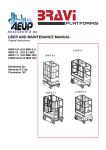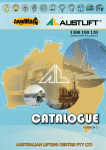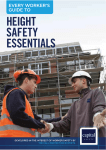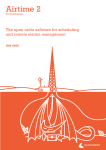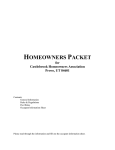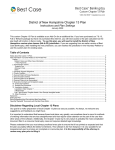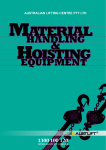Download Construction Testing Concrete Pumps Code of Practice
Transcript
WorkCover on Disk - Codes of Practice CODE OF PRACTICE Construction Testing Concrete Pumps gazetted 26 November 1993, commenced 1 March 1994 1. Introduction 1.1 Citation This Code of Practice may be cited as, Code of Practice, Construction and testing of concrete pumps 1993. 1.2 Purpose This Code of Practice sets out guidelines for the construction and testing of concrete pump units and placing booms, pipes, hoses and couplings. 1.3 Scope This Code applies to pump units, placing booms and ancillary equipment used for the conveyance of concrete where the pump unit is skid mounted, trailer mounted or vehicle (prime mover) mounted. 1.4 Commencement This Code of Practice commences on 1 March 1994 1.5 Authority This Code of Practice is approved as an Industry Code of Practice pursuant to section 44A of the Occupational Health and Safety Act, 1983, by the Minister of Industrial Relations and Employment on the recommendation of the WorkCover Authority of NSW. 2. Pump unit Dangerous parts should be safeguarded as far as practicable in accordance with the Occupational Health and Safety Act, 1983 and Regulations. 2.1 Mounting a. Skid mounted - lifting eyes, or fittings for attaching lifting gear, should be provided to ensure the safe handling of the pump unit by crane. A clearly visible permanent notice indicating the overall weight should be fixed to the unit. b. Trailer mounted - Trailers should be constructed in accordance with RTA regulations if the unit is designed for towing on public roads. c. Vehicle mounted - the vehicle and equipment should comply with RTA regulations and be fitted with an audible reverse warning device. A permanent notice should be fixed in the driver’s cab to indicate the maximum height of the unit in travelling order. d. Concrete pump and boom manufacturers, or firms responsible for mounting these components on vehicles, should ensure that the vehicle selected is suitable for the equipment to be mounted. In particular, the vehicle should be assessed for: (i) Axle loadings and gross vehicle weight including any additional weight of ancillary equipment such as a full water tank for routine tasks, pipes, hoses and couplings. (ii) Power/weight ratio. (iii) Performance on the highway. (iv) Performance under site conditions. (v) Stability, both on the highway and under site conditions. (vi) Torsion of chassis frame. WorkCover on Disk - Codes of Practice (vii) Engine cooling. (viii)Auxiliary power takeoff(s). 2.2 Outriggers Mobile or trailer mounted pumps should have outriggers, jacks or axle locks to provide stability during pumping operations. A permanent notice should be fixed at a point near each outrigger on mobile boom pumps, indicating the maximum force in kN that can occur at the foot of a fully extended outrigger. See Appendix - Safety stickers. 2.3 Receiving hopper The receiving hopper should be positioned on the mounting so that it can receive concrete flow readily from the discharge chute of the truck mixer. A hinged grill should be provided to prevent access to dangerous moving parts such as feed or agitator mechanisms and valve gear. The grill should be constructed of parallel bars, spaced so that it is not possible for a person’s hand to become trapped. Spacing should not exceed 70mm and the distance from grating to moving parts should be a least 150mm. 2.4 Access steps and working platforms Access steps and working platforms should be designed for the operator’s safety. 3. Placing booms and boom pipelines 3.1 Placing booms Placing booms and associated slewing mechanisms and mounting should be designed and constructed to withstand the static and dynamic loads to which they may be subjected in use. The effects of fatigue, wind loadings and service factors should also be taken into account. Design should allow for the use of suitable placement hoses. Lengths of hoses should be in accordance with manufacturers’s recommendations. Where booms are mounted on separate bases or tower structures these should also be suitably designed and adequately mounted. Provision should be made to secure the boom in the stowed position for travelling. Many aspects of the design of placement booms is similar to cranes. The appropriate sections of AS1418 - SAA crane code or DIN 24117 - Machines for the building and building materials industry should therefore be applied to the design of placing booms for concrete pump units. 3.2 Boom pipelines Each section of rigid pipeline or flexible hose should be anchored to the booms so that in the event of a coupling failure, no section of pipe or hose can fall from the boom. Metal pipe swivels should be fitted in place of flexible hoses to accommodate the folding of boom sections. (Delivery pipes and flexible hoses supported by the boom and their adaptors and couplings should be as specified in sections 10 and 11.) 3.3 Pipeline - security and reactions Concrete pumping lines are secured to the building or structure to withstand the often powerful reaction forces from high pump pressures. It is essential that the reaction blocks or mountings at changes of direction of pipelines are designed to withstand these forces. 3.4 Safety fittings Use chains, wire ropes or webbing slings as a safety measure to secure sections of pipe such as reducers, rubber hoses and bends which are liable to fail at the joint when attached to the final outlet of boom drop hose. Safety chains, wire ropes or webbing slings should have a minimum safe working load of 1,200kg. Reducers should have compensation plates to which the anchorages are welded. 4. General design requirements WorkCover on Disk - Codes of Practice Concrete pumps and concrete placing booms should comply with the applicable engineering standards. Modifications are allowed only if the required safety standards are met. Wherever possible, before modifications are made seek the advice of the manufacturer. 4.1 Guarding All exposed moving parts should be guarded to prevent any body part making contact with any moving part. Truck engines that drive concrete pumps should not be able to be started from the control panel of the concrete pump. An exception is for engines that can only be started with all gears in neutral. 4.2 Marking The following information should be displayed. a. Concrete pumps: (i) Manufacturer or supplier (ii) Year of manufacture (iii) Serial number (iv) Model or type (v) Maximum permissible operating pressure of the pump hydraulic system (in bar) (vi) Maximum concrete pipeline pressure (in bar). b. Concrete placing booms: (i) Manufacturer or supplier (ii) Year of manufacture (iii) Serial number (iv) Model or type (v) Maximum permissible operating pressure of the boom hydraulic system (in bar) (vi) Maximum permissible pipeline internal diameter in millimetres and maximum hose length in meters (vii) Any restrictions on specified areas of operation. 4.3 Safety stickers Safety stickers for pumps, boom pumps and tower booms should be affixed to equipment in accordance with schedule contained in Appendix - Safety stickers. 5. Hydraulic operation of the pump and boom 5.1 General The specification and construction of hydraulic systems should be designed for the safety of personnel and long life of equipment. 5.2 Horizontal stabilisers (outriggers) Outriggers should have positive locking when fully extended or retracted. 5.3 Hydraulic cylinders Hydraulic cylinders on concrete placing booms and hydraulic outriggers should be fitted with controllable non-return valves so that the pressure in the hydraulic cylinder is maintained if a hose or pipe bursts. A connecting pipeline between any cylinder and respective controllable non-return valve is prohibited. 6. Controls 6.1 Markings WorkCover on Disk - Codes of Practice Controls should be clearly marked with symbols or words (in English) to show their function. Where practicable the direction of movement of a control should correspond with the direction of motion being controlled. (See Appendix - Safety stickers for recommended symbols.) 6.2 Control selections The control system should be arranged so that control selections cannot cause a motion not intended by the operator, unless essential for the operation of a safety device or interlock. 6.3 Dead man controls Where there is more than one set of controls, the pump unit should be operable from only one position at any time. Controls for slewing, luffing and folding the boom should automatically return to the OFF position when the lever or knob is released by the operator. All controls (including remote controls) should be full ’dead man’ so that in the event of operator release they return to neutral and lock-in position. 6.4 Radio controls All full radio remote control systems should be approved by Telecom with a closely monitored transmitting frequency unique to the one machine. It is essential that interference is not possible from another machine or from other sources that could accidentally operate the machine by remote control. Controls should be water tight to prevent water leaking into electrical switch contacts causing an unselected movement of the control due to circuit "bridging". 6.5 Controls mounted on pump unit The controls should be positioned so that the operator has a clear view of the receiving hopper and of the placing boom (if fitted). The control station should be located so that the operator cannot be struck by the boom when using the controls. Steps and handholds should be provided to give safe access to platforms or seats. 6.6 Hydraulic controls For hydraulic powered engines the main control panel should include a gauge to indicate the pressure of the fluid supplied to the concrete pumping mechanism. Where a hydraulic accumulator is installed or, if the valve is controlled by a separate hydraulic circuit, the panel should also include a gauge to indicate pressures of fluid supplied to the valve mechanism. Each gauge should be clearly labelled. 7. Pump unit stability testing 7.1 Testing standard All tests should be carried out in accordance with DIN 24117 or the stability test procedure laid down by the manufacturers. 7.2 Test weights Test weights should be suspended at points along the boom as specified by the manufacturer. 7.3 Test conditions When conducting a stability test the amount of fuel oil and the volume of washing water in the tanks should be the most unfavourable to the stability of the machine. 7.4 Stability tests Stability tests should be carried out by the boom manufacturer or their qualified representative before putting a newly manufactured concrete placing boom into service. Stability tests should also be carried out whenever modifications are made to a concrete placing boom or boom-type concrete pump that may affect stability. The results of all stability tests should be recorded in the machine’s log book. 8. Noise 8.1 Noise levels WorkCover on Disk - Codes of Practice Concrete pumps should be constructed to ensure the minimum possible noise levels during operation. 9. Instruction and service manuals Instruction manuals should be supplied with the pump unit and boom, giving comprehensive instructions for operation, testing, maintenance and repair and include a parts catalogue. A service manual should be supplied with the pump unit and boom detailing the frequency and type or service to be carried out. Manufacturers and suppliers of pump units and booms should notify the pump owners of any alterations or additions to these manuals. 10. Delivery pipelines 10.1 General Manufacturers of concrete pumps and placement booms are responsible for specifying the internal diameter and wall thickness of the delivery pipes to be used with their equipment. 10.2 Materials for pipes The pipe should safely withstand the maximum working pressure in service, have an adequate service life, and not have any detrimental effects on the concrete. 11. Flexible hoses 11.1 General Flexible hoses used as placing hoses and connected to lengths of rigid pipe in a delivery pipeline should be specified by concrete pump and placement boom manufacturers to avoid being subjected to pressures higher than those recommended. Flexible hoses should be clearly marked with the: a. Manufacturer or supplier’s name. b. Recommended operating pressure. Fabric hose safety factor 4 to 1. Steel braided hose safety factor 1.75 to 1. 11.2 Construction of hose Hose construction and materials should safely withstand the pressure in service, have an adequate service life, and not have any detrimental effects on the concrete. 11.3 The suggested minimum operating pressures are: 50mm (2"): 54 bar (800 psi) 75mm (3"): 47 bar (700 psi) 89mm (3"): 34 bar (500 psi) 100mm (4"): 34 bar (500 psi) 125mm (5"): 34 bar (500 psi) 12. Coupling system 12.1 General Couplings should be designed and constructed for use and maintenance under site conditions. The coupling and gasket should provide a leak-proof joint and allow for a small angular movement between the two pipes they join. WorkCover on Disk - Codes of Practice 12.2 Couplings should: a. Be either the rigid type secured by bolts or a quick release type that can maintain positive closure of the clamp such as a safety pin. b. Have the safe working pressure they can withstand specified by the manufacturer. (Substantiated by NATA test certificate.) (i) Incorporate a minimum safety factor of 2:1. (ii) Have safety pins provided for lever (toggle) type couplings used on all booms and fixed pipeline installations. 12.3 Pipe end fittings The type of end fittings on concrete pipelines and the clamping devices should suit the pressures attainable by the equipment being used. a. Do not use pipes with grooved ends where a groove is machined or rolled directly into the outside of the pipe wall for conveying concrete. b. The light shrink or welded rings of under 4mm thickness should only be used on systems with a maximum attainable pressure of 50 bar (750 psi) and NEVER on reducers or any pipeline with an internal diameter greater than 100mm. 13. Reducers A reducing pipe that is a component of the pump unit should have couplings capable of withstanding the maximum concrete pumping pressure. Reducers should be joined by a quick-release type coupling with a facility for maintaining positive closure of the clamp when they have to be dismantled quickly due to a blockage. Definitions For the purpose of this code, the following definitions apply: "Australian Standard (AS)" A standard rule, code or specification of Standards Australia. "Axle lock" A device that may be fitted on mobile pump units to prevent relative movement between a sprung/pivoted road axle and the chassis frame in order to increase stability in service. "Bar" A unit pressure. 1 bar = 100 kPa or 14.5 psi. "Catch basket" A device fitted to the delivery end of the pipeline, when the clean-out adaptor is used to catch the sponge rubber balls or wads used in the cleaning operation. "Clean out adaptor" A short length of pipe with one end blanked off and connections for a water or air hose coupled to the pipeline for cleaning purposes. It should have a separate air relief valve vented to atmosphere and a pressure gauge when used with compressed air. "Competent person" Means a person who an employer ensures has acquired through either training, qualification, or experience or a combination of those, the knowledge and skill to correctly perform the task required. "Conditions of tipping" A pump unit should be considered to be in the condition of tipping when the stability moment equals the overturning moment. "Coupling system" The means of joining sections of delivery pipeline. "Delivery hose" A flexible hose used in or at the end of the pipeline. "Delivery pipeline" Portable rigid or flexible piping supplied in sections with the provision for joining together with a coupling system. "DIN" Deutsche (German) Industrial Standard. "Engineer" A person eligible for membership of the Australian Institute of Engineers, who has a knowledge of the relevant regulations, and knowledge of concrete pumps and placing booms. WorkCover on Disk - Codes of Practice "NATA" The National Association of Testing Authorities "Outriggers" Extendible structural members on the pump unit to increase the dimensions of the stability base. "Owner" The owner of any plant or substance, or the controller manager, lessee, mortgagee, hirer or borrower. "Placing boom" A device to support and position the delivery pipeline. It can incorporate folding, luffing, extending and slewing motions. "Principal contractor" A person or company contracted by the owner to carry out the work. "Pump unit" The concrete pump and the mounting. "Reducer" A pipe that changes the internal diameter of the pipeline. "RTA" The Roads and Traffic Authority of NSW Appendix - Safety stickers Safety stickers should be maintained so that they can be easily read by the operator or persons near to the concrete pump and/or boom. They should be replaced if they cannot be easily read. Safety stickers should be located in positions indicated below. If no space is available safety stickers should be fixed to sheet metal mountings attached to the concrete pump and/or boom, provided by the machine’s owner. CPA 1 To be visible to a person standing behind the concrete pump who is looking into the concrete hopper. The sticker should not be lower than the lowest rim of the hopper and is ideally located on or above the splash board at the back of the hopper. CPA 1 - 1 No. 220 x 135 mm. Black on Yellow WorkCover on Disk - Codes of Practice CPA 2 One sticker on each side of the concrete pump visible to the operator in the operating position. CPA 2 - 2 No. 220mm x 100 mm. Black on Yellow WorkCover on Disk - Codes of Practice CPA 3 One sticker on each side of the concrete hopper. CPA 3 - 2 No. 220 x 150 mm. Black on Yellow WorkCover on Disk - Codes of Practice CPA 4 (a) Squeez-Crete type pumps One sticker on either side of the rotary pump housing. (b) Piston pumps One sticker on the rear of the hopper adjacent to the concrete valve outlet/s. One sticker visible to the operator in the operating position. CPA 4 - 2 No. 220 x 150 mm. Black on Yellow WorkCover on Disk - Codes of Practice CPA 5 WorkCover on Disk - Codes of Practice To be visible to a person at the operating position, ie, the position where a person would start the pump engine and control the pump. CPA 5 - 1 No. 120 x 170 mm. Red/Black on White CPA 6 To be visible to a person standing beside the concrete pump generally toward the rear of the machines. Post only if the concrete pump can be stop-started by remote control. CPA 6 - 2 No. 220 x 150 mm. Black on Yellow WorkCover on Disk - Codes of Practice CPA 7 To be visible to a person at the operating position. CPA 7 - 1 No. 280 x 220 mm. Black on White WorkCover on Disk - Codes of Practice CPA 8 Two stickers, each to be fixed high on the boom pedestal or slewing column-head visible from each side of the machine to a person standing beside the machine. CPA 8 - 2 No. 250 x 175 mm. Black on Yellow WorkCover on Disk - Codes of Practice CPA 9 One sticker to be fixed each side of the last boom arm as near as practical to the end of the boom. It should be fixed so that it is WorkCover on Disk - Codes of Practice easily read when the boom is in the normal working position. (With roll-fold booms this may mean that it will appear upside down when the boom is folded for transport.) CPA 9 - 2 No. 220 x 120 mm. Black on Yellow CPA 10 Two stickers to be fixed on each side of each hydraulic outrigger. CPA 10 - 2 No. 220 x 150 mm. Black on Yellow WorkCover on Disk - Codes of Practice CPA 11 One sticker on each side of the concrete pump placed adjacent to the outrigger control levers. The sticker should be clearly visible to a person using the outrigger controls to set up the boom pump. CPA 11 - 2 No. 220 x 150 mm. Red/Black on White WorkCover on Disk - Codes of Practice CPA 12 One sticker to be visible to a person at the operating position. One sticker to be fixed inside the truck cabin, ideally on the dashboard where it is visible to both the driver and passenger(s). The remaining two stickers should be placed on either side fo the concrete pump, at the rear. That is, on the hopper sides, catwalk sides or visible to persons standing near to the rear sides of the concrete pump unit. CPA 12 - 2 No. 120 x 75 mm. Red/Black on White WorkCover on Disk - Codes of Practice CPA 13 WorkCover on Disk - Codes of Practice Two stickers should be placed adjacent to stickers CPA 8 and two stickers should be placed adjacent to stickers CPA 9. CPA 13 - 2 No. 120 x 150 mm. Red/Black on White CPA 14 (a) One sticker should be fixed to each of the rear sides of the concrete pump near to the operating position and in a location that is visible to persons generally standing nearby such as truck mixer drivers or persons likely to be talking to the pump operator. (b) One sticker to be placed on the inside face of each front outrigger leg so that the sticker is clearly visible from the upper end of the pump when the outrigger leg is extended or folded out. CPA 14 - 4 No. 120 x 150 mm. Red/Black on White WorkCover on Disk - Codes of Practice CPA 15 One sticker to be visible to a person at the operating position and adjacent to CPA 12. One sticker to be fixed immediately beside the boom remote control cable output terminal box visible to a person unpacking or stowing the remote control cable (were fitted). CPA 15 - 2 No. 120 x 165 mm. Red/Black on White WorkCover on Disk - Codes of Practice CPA 16 To be fixed to the truck dashboard clearly visible to the truck driver and passenger/s. CPA 16 - 2 No. 70 x 85 mm. Black on Yellow CPA 17 To be fixed nearby to the operating position next to CPA 7. WorkCover on Disk - Codes of Practice 1. Boom Up WorkCover on Disk - Codes of Practice 2. Boom Down WorkCover on Disk - Codes of Practice 3. Boom Left WorkCover on Disk - Codes of Practice 4. Boom Right WorkCover on Disk - Codes of Practice 5. Open or Extend Boom WorkCover on Disk - Codes of Practice 6. Close or Retract Boom WorkCover on Disk - Codes of Practice 7. Stop Boom WorkCover on Disk - Codes of Practice 8. Start Pump Speed Up WorkCover on Disk - Codes of Practice 9. Slow Down Pump WorkCover on Disk - Codes of Practice 10. Stop Pump WorkCover on Disk - Codes of Practice 11. Little Bit WorkCover on Disk - Codes of Practice 12. Add Water WorkCover on Disk - Codes of Practice 13. All Done Clean Up



































